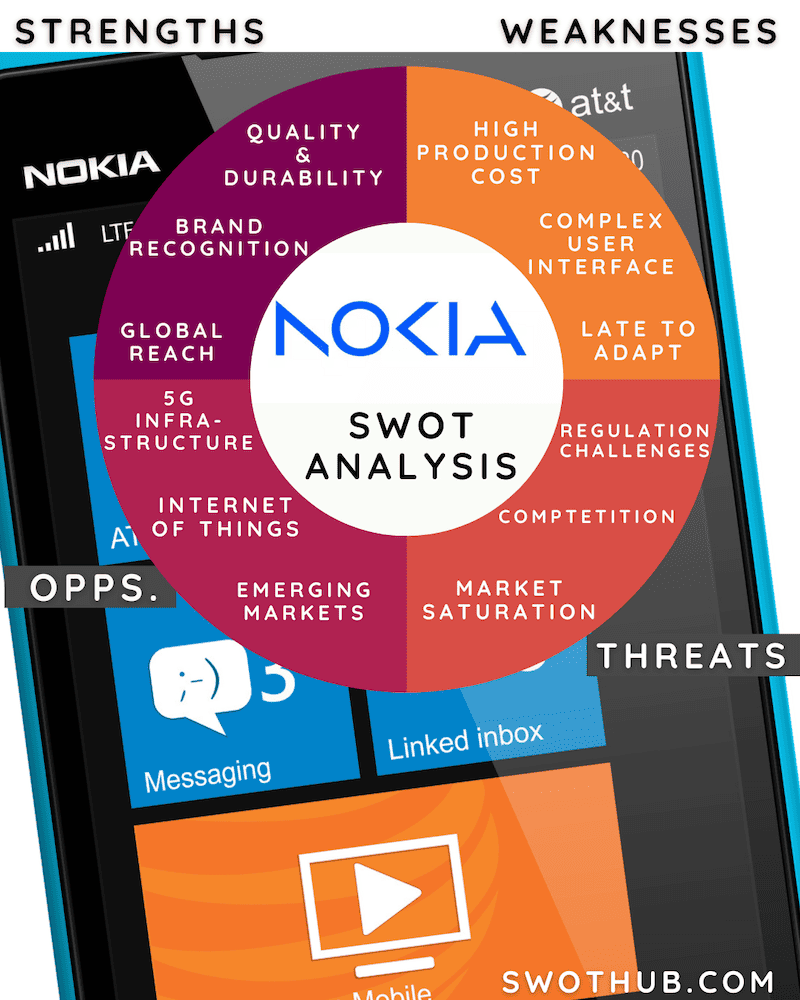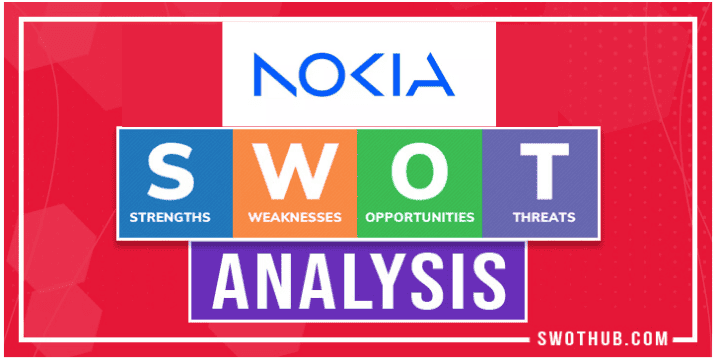As a pioneering company that transitioned from a paper mill to a global technology leader, Nokia’s journey is a case study of adaptability and resilience. For anyone interested in technology and telecommunications, understanding a Nokia SWOT analysis offers a rich perspective on how to navigate the complexities of a fast-paced industry. Let us take a look at the analysis of the rise through Nokia’s strengths, weaknesses, opportunities, and threats to its competitors.
Table of Contents
Nokia History
Founded in Finland in 1865, Nokia initially dealt in paper products before branching out into various sectors, including rubber and electronics. By the 21st century, Nokia had become a global leader in mobile phones. Though it faced challenges with the advent of smartphones, the company successfully pivoted towards network infrastructure and telecommunications services, becoming a force to reckon with in 2023.
Nokia SWOT Analysis at a Glance
| Company | Nokia |
| Industry | Technology and Networking |
| Founder | Fredrik Idestam |
| Year founded | 1865 |
| CEO | Pekka Lundmark |
| Headquarters | Espoo, Finland |
| Number of employees | 86,896 +/- (2022) |
| Revenue (FY 2022) | 24.91B EU |
The Rise and Fall of Nokia
SWOT Analysis of Nokia
A SWOT analysis of Nokia serves as a comprehensive tool for assessing the company’s current situation. The report will evaluate Nokia’s strengths, weaknesses, opportunities, and threats, providing detailed knowledge of the company’s competitive positioning.
Nokia SWOT Analysis Strengths:
Numerous significant strengths that give Nokia a competitive advantage support its position as a technology leader.
Strong Brand Recognition: Nokia’s long history as a dependable brand makes it stand out. Consumers frequently associate Nokia with quality and longevity, both of which can be used to increase customer retention and loyalty.
Strong R&D Capabilities: Nokia invests extensively in R&D, which fuels its technological innovation. This emphasis positions it as an industry trendsetter capable of fulfilling future market demands.
Immense Global Reach: Nokia’s operations reach more than 130 countries, providing a substantial market footprint. This global reach enables risk diversification and access to a diverse range of consumer demographics.
Quality and Durability: In a Nokia SWOT analysis, it is well known for producing high-quality, long-lasting goods. This reputation gives the company a competitive edge, particularly in regions where product durability is highly valued.

Nokia SWOT Analysis Weaknesses
A thorough examination must also consider any flaws or threats that may impede Nokia’s advancement. Weaknesses are areas that require improvement. In this phase of our Infosys SWOT analysis, we’ll look at the weaknesses that could stymie the company’s progress.
Late to Adapt: Nokia’s tardy response to the smartphone revolution cost it a substantial part of the market. This lack of adaptability has been a learning experience, emphasizing the significance of timely innovation.
Complex User Interface: Despite its superior hardware capabilities, Nokia’s software is less user-friendly than its competitors. This intricacy may dissuade potential customers who value ease of use.
Limited Diversification: Nokia’s portfolio is less varied than that of certain competitors. Its primary focus on telecommunications and network infrastructure limits its potential for growth in other technology industries.
High Production Costs: Because high production costs are frequently passed on to consumers, Nokia’s solutions are less competitive in price-sensitive areas.
Nokia SWOT Analysis Opportunities:
The continuously changing technological world provides several opportunities for advancement.
5G Infrastructure: The global push for 5G presents huge potential for Nokia. Because of its technological skills, the corporation is a strong choice for developing 5G infrastructure.
Integration of the Internet of Things (IoT): The advent of the Internet of Things (IoT) opens up new opportunities for Nokia’s networking solutions. Nokia can become a go-to brand for networked products by focusing on IoT.
Emerging Markets: Developing countries offer fertile ground for expansion, particularly in areas where technology adoption is increasing.
Collaborations: In a Nokia SWOT analysis, Nokia should consider partnering with other technological companies, which could provide new possibilities for expanding product offerings and accessing new industries.
Nokia SWOT Analysis and Threats:
Several obstacles could stifle Nokia’s growth trajectory. Threats pose a risk to every company’s stability and profitability. Some of its largest threats compared to competitors include:
Market Saturation: The technology industry, particularly the smartphone market, is oversaturated. To acquire a competitive advantage, Nokia must differentiate its goods.
Strong Competitors: Huawei and Ericsson are formidable network infrastructure rivals.
Regulatory Challenges: Navigating the tangle of global regulations and policies necessitates ongoing awareness.
Technological Redundancy: Rapid technological advances can swiftly render old products obsolete, necessitating ongoing innovation.
Nokia Competitors:
- Huawei: In a Nokia SWOT analysis, a major player in the telecommunications and network infrastructure markets. The Chinese behemoth has a diverse portfolio of products and has made considerable advances in 5G technology, directly competing with Nokia.
- Ericsson: Based in Sweden, is another network infrastructure behemoth. Ericsson, like Nokia, has invested extensively in R&D for 5G technology, and the two companies frequently compete for the same contracts around the world.
- Cisco Systems Inc.: Cisco is a global corporation based in the United States that manufactures networking gear, software, and telecommunications equipment. It is a formidable rival, particularly in the enterprise market, where large-scale network solutions are required.
- ZTE: A Chinese business that operates in the telecommunications and information technology industries. They provide network solutions and are expanding their footprint in new markets, which could pose a challenge to Nokia’s growth objectives.
- Each of these competitors poses a different challenge to Nokia, whether through technological innovation, expanded service offerings, or market penetration. This competitive study might be beneficial to business executives and students interested in the complexities of the technology and telecom industries.
Nokia SWOT Analysis – Conclusion and Recommendations:
Nokia needs to focus on a number of key strategies to remain competitive in the technology and networking industries.
Understanding Nokia’s SWOT analysis is critical for understanding its competitive position. The highlighted strengths can serve as a model for sustaining its competitive advantage, while the identified shortcomings indicate opportunities for quick development.
- Enhance User Experience: Nokia should invest in making its software easier to use.
- Increase Product Portfolio Diversification: Expanding into new technology fields can provide extra revenue streams.
- Cost-Efficiency: The organization must investigate ways to provide cost-effective solutions without sacrificing quality.
If adopted, the ideas can boost Nokia’s competitiveness and market share.
FAQs of SWOT Analysis of Nokia
What caused Nokia’s downfall?
Nokia’s downfall was primarily due to its late adaptation to the smartphone revolution and the rise of competitors like Apple and Samsung. They stayed with their Symbian operating system, which had become obsolete.
What challenges is Nokia facing?
In the networking and telecommunications market, Nokia is up against Huawei, Ericsson, and Cisco. Rapid technological change, as well as the complexities of global regulations, bring additional obstacles.
What is Nokia’s strategic goal?
Nokia’s strategy aims to dominate network infrastructure, software, and services, targeting end-to-end 5G solutions.
This expanded Nokia SWOT analysis is intended to provide business professionals, investors, and academics with a more in-depth insight into Nokia’s market position. We may appreciate the deep processes defining this technological behemoth by analyzing both its vulnerabilities and potential.





